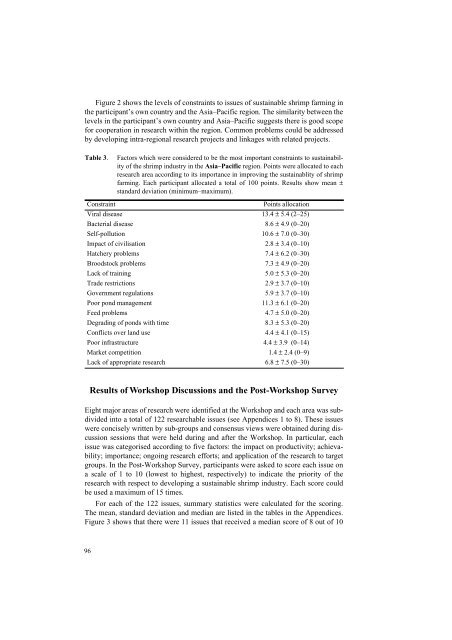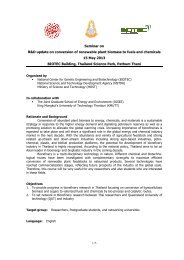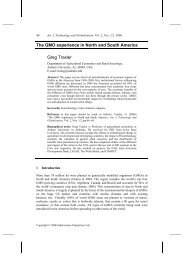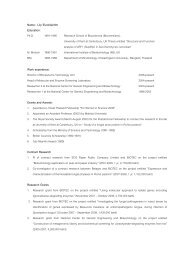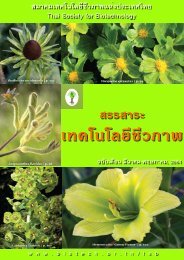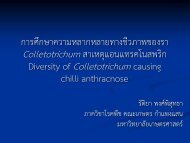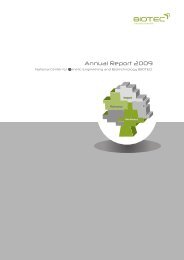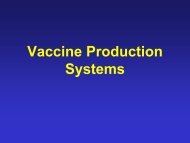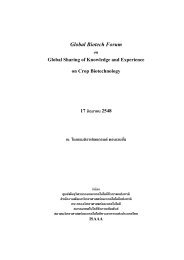Coastal Shrimp Aquaculture in Thailand: Key Issues for Research
Coastal Shrimp Aquaculture in Thailand: Key Issues for Research
Coastal Shrimp Aquaculture in Thailand: Key Issues for Research
Create successful ePaper yourself
Turn your PDF publications into a flip-book with our unique Google optimized e-Paper software.
! ! ! ! ! ! ! ! ! ! ! ! ! ! ! ! !Figure 2 shows the levels of constra<strong>in</strong>ts to issues of susta<strong>in</strong>able shrimp farm<strong>in</strong>g <strong>in</strong>the participant’s own country and the Asia–Pacific region. The similarity between thelevels <strong>in</strong> the participant’s own country and Asia–Pacific suggests there is good scope<strong>for</strong> cooperation <strong>in</strong> research with<strong>in</strong> the region. Common problems could be addressedby develop<strong>in</strong>g <strong>in</strong>tra-regional research projects and l<strong>in</strong>kages with related projects.Table 3.Factors which were considered to be the most important constra<strong>in</strong>ts to susta<strong>in</strong>abilityof the shrimp <strong>in</strong>dustry <strong>in</strong> the Asia–Pacific region. Po<strong>in</strong>ts were allocated to eachresearch area accord<strong>in</strong>g to its importance <strong>in</strong> improv<strong>in</strong>g the susta<strong>in</strong>ablity of shrimpfarm<strong>in</strong>g. Each participant allocated a total of 100 po<strong>in</strong>ts. Results show mean &standard deviation (m<strong>in</strong>imum–maximum).Constra<strong>in</strong>tPo<strong>in</strong>ts allocationViral disease 13.4 & 5.4 (2–25)Bacterial disease 8.6 & 4.9 (0–20)Self-pollution 10.6 & 7.0 (0–30)Impact of civilisation 2.8 & 3.4 (0–10)Hatchery problems 7.4 & 6.2 (0–30)Broodstock problems 7.3 & 4.9 (0–20)Lack of tra<strong>in</strong><strong>in</strong>g 5.0 & 5.3 (0–20)Trade restrictions 2.9 & 3.7 (0–10)Government regulations 5.9 & 3.7 (0–10)Poor pond management 11.3 & 6.1 (0–20)Feed problems 4.7 & 5.0 (0–20)Degrad<strong>in</strong>g of ponds with time 8.3 & 5.3 (0–20)Conflicts over land use 4.4 & 4.1 (0–15)Poor <strong>in</strong>frastructure 4.4 & 3.9 (0–14)Market competition 1.4 & 2.4 (0–9)Lack of appropriate research 6.8 & 7.5 (0–30)Results of Workshop Discussions and the Post-Workshop SurveyEight major areas of research were identified at the Workshop and each area was subdivided<strong>in</strong>to a total of 122 researchable issues (see Appendices 1 to 8). These issueswere concisely written by sub-groups and consensus views were obta<strong>in</strong>ed dur<strong>in</strong>g discussionsessions that were held dur<strong>in</strong>g and after the Workshop. In particular, eachissue was categorised accord<strong>in</strong>g to five factors: the impact on productivity; achievability;importance; ongo<strong>in</strong>g research ef<strong>for</strong>ts; and application of the research to targetgroups. In the Post-Workshop Survey, participants were asked to score each issue ona scale of 1 to 10 (lowest to highest, respectively) to <strong>in</strong>dicate the priority of theresearch with respect to develop<strong>in</strong>g a susta<strong>in</strong>able shrimp <strong>in</strong>dustry. Each score couldbe used a maximum of 15 times.For each of the 122 issues, summary statistics were calculated <strong>for</strong> the scor<strong>in</strong>g.The mean, standard deviation and median are listed <strong>in</strong> the tables <strong>in</strong> the Appendices.Figure 3 shows that there were 11 issues that received a median score of 8 out of 1096


